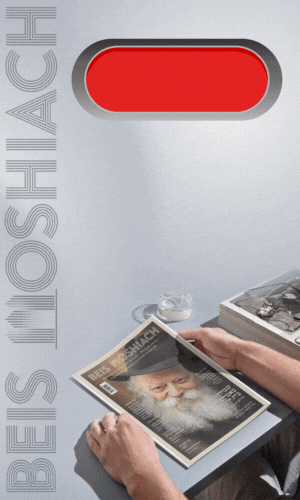Why Remote Learning is Better?
Rather than the wish that corona go away or the hope of obliterating corona, we need to change the conversation. To fight the real problem. The problem is that we and our students are stuck deep in galus when our real place is Geula • Interview with eighth grade rebbi, Rabbi Mendy Arad • By Beis Moshiach Magazine • Full Article
Avrohom Rainitz, Beis Moshiach
I caught Rabbi Mendy Arad between a zoom shiur he gives to talmidim of the Talmud Torah (elementary school) and a lecture he travels to deliver in person.
That’s odd – you are not in the classroom but you show up for lectures?
I’d be happy to go to yeshiva too, but the fact is that our Talmud Torah is in a “red city” which forced us to close and revert to long-distance learning.
What’s it like to teach from afar?
I’ll answer with an anecdote. R’ Mendel once asked a bachur at a farbrengen, “Who is the holiest person in the world?” When the bachur began giving answers like Adam, Moshe Rabeinu, Aharon HaCohen, the Rebbe, R’ Mendel corrected him and said, “The holiest person in the world is you!”
R’ Mendel went on to ask him about the holiest location. When the bachur said the Beis HaMikdash, the Kodesh Kodashim, the Rebbe’s room, R’ Mendel corrected him and said, “The holiest place is where you are. The place where you are now, physically, emotionally, spiritually. And of course, the holiest moment is right now!”
I recently heard a fantastic vort on the pasuk, “In the place that Hashem will choose.” This place is not only the place that Hashem chose to rest his Shechina, i.e. the Mishkan and the Beis HaMikdash and battei mikdash me’at, but your place, the place you are in now; the place that Hashem chose for you to be in right now.
True, it is easy to dream and think about what was and what will be but we daven for the Satan to be removed from before us and behind us … The job of a Chassid is to seek out the best in the situation he is presently in.
In research that I did before this interview with you, I was made to understand that you believe in this situation of long-distance learning and even hold it up in your lectures as the optimal arrangement. How can that be?
You did amazing research. Yes. Allow me to respond in a long-short way.
At the beginning of the summer, Chabad schools asked me to construct for orientation day a lecture on “Beginning the School Year from a Distance.” I thought about it: What added value can I contribute to the Rebbe’s shluchim in chinuch. What’s the news, the change, the special and unforgettable thought paradigm that I can give them. When you are invited to lecture, the most important thing is to provide the audience with something new. I asked myself: What new idea can I give them?
I was reminded of a lecture that I heard some years ago from Dovid Be’eri, founder of Amutat El-ad (Ir David Foundation – el = to, ad = Heb abbreviation of Ir David) which succeeded in turning “Ir David” into an international heritage site. In that lecture, he spoke about “The Battle for Awareness.” That is what he called his tireless efforts to restore the original name of the site to “Ir David” (City of David), a name that arouses powerful feelings in the heart of every Jew and to some extent even ordinary people; and not “Silwan,” a name that is cold and alien, distant and lacking any sense of connection.
His success is pretty huge, if only for the fact that a foundation that could be perceived as politically right-wing became an operation that is a part of mainstream Israeli life, completely within the so-called consensus.
I wondered, what is “The Battle for Awareness” that we need to transmit. Rather than the wish that corona go away or the hope of obliterating corona, we need to change the conversation. To fight the real problem. The problem is that we and our students are stuck deep in galus when our real place is Geula.
How did the Geula become the guiding light in the battle against corona in your lectures?
One minute. I believe that a person can jolt and move others only with what jolts and moves him, with an insight that changes his way of thinking, his perspective.
I sat and pondered this a great deal. I opened up sefarim and learned and still did not have even the “tip of a thread” of insight. Then I came across an interview that was done with Rabbi YY Jacobson in the Ki Karov leaflet. This was a ten-page fascinating interview under the heading, “Why, before the Geula, is there the greatest degradation?”
R’ Jacobson laid out in this interview what he considered to be a discovery for him as a result of learning a maamar of R’ Hillel of Paritch, that the exile, the crisis, the tribulations and hardships are not a station on the way to Geula or even a preparation for the Geula. It’s the opposite; the Geula is on the threshold and this is the reason that the moment before it there is galus.
Really?
Definitely. The mashal is brought many times in Chassidus about a galus state that is really hidden good and a preparation for Geula – a teacher who withdraws from the student in the middle of the lesson.
When an amazing new redemptive insight flashes through the mind of the teacher that he wants to share with the student, so his life will be different, wonderful, Geula-like, paradoxically he suddenly withdraws from the student. He gives no warning; he simply withdraws and is struck dumb. The student feels the teacher abandoning him, but the truth is that this is the most loving moment possible. The disconnect is for the purpose of connecting.
If someone would suggest taking teachers out of the classroom for an extended vacation so they could “intensify their inner love toward the students,” I don’t think this would generate many plaudits.
Clearly we are not speaking of cutting off the connection, and certainly not as part of a planned strategy. However, if we have already been forced into a sort of disconnect, even if it’s external, our job as educators is to intensify the love and instill within ourselves our real goals as educator.
What are the real goals?
In lectures I’ve given in schools around the country to staff members, I’ve asked them to answer three simple questions: What are you trying to accomplish in your educational work? How do you go about accomplishing this? Why are you trying to accomplish this?
The fascinating thing is to see how each one said the same thing in his own words, but the message was the same. But the unique discovery lies in the secret of success leaders in every field, in every time period and every generation, which is to start with the existential question: Why am I doing what I’m doing.
For example, the computer giant Apple is more successful in several areas than all other companies. What is their secret? Although what they do is manufacture computers, they could just as well do anything else. They are driven by the “why,” by the vision, the idea to “think differently,” i.e. they are always challenging the status quo. All the time, in every thing, and on every subject.
People don’t buy what you make; they buy the idea behind why you make what you make.
What is the “why” for educators?
It is not the “why” for educators but that of every Jew, certainly that of parents who are educating their children. We have a clear goal, from the first moment we open our eyes for the first time in our lives, and that is: to bring about Yemos HaMoshiach.
They tell about President Kennedy whose dream it was to send man to the moon within the decade. When he visited NASA he noticed a janitor carrying a broom. He walked over to the man and said, “Hi, I’m Jack Kennedy. What are you doing?”
“Well, Mr. President,” the janitor responded, “I’m helping put a man on the moon.” When Kennedy heard that, he was very moved and told himself that now he was sure it would happen.
A vision for something that does not yet exist does not only depend on the executive offices, but has to trickle down through all of middle management all the way down to the field of action, the belief that it is a true vision, doable, practical, measurable and attainable. Then you have a true vision.
Ask any Lubavitcher child, who are we? What is our role? He will instantly tell you, this is how we bring the Geula closer. Listen to the song, “Shim’u shim’u rabbotai … l’ma sh’tziva Ha’Rebbe M’Lubavitch” which lists everything Lubavitchers do on mivtzaim. The song ends with, “then Moshiach will quickly come.”
What’s the chiddush in that everything we do leads to Geula? How does that illuminate the dark period of corona and long-distance learning?
I’ll answer with a question: What does the word Geula mean?
It’s my job to ask the questions …
Still, it’s in every Jew’s genes to answer with a question … Let’s try and understand what the word Geula means, not “what will happen in the Geula,” and not “why do we need the Geula” and “how do we hasten the Geula.” The question is, what does the word mean.
Geula means bringing the “Alufo shel olam” into galus existence.
Very good and yet, we explain the essence of Geula based on prior knowledge that we have. When we want to translate the word Geula, we look in the sources.
The first time the word Geula appears is in Vayikra (25:24), “Therefore, throughout the land of your possession, you shall give redemption (geula) for the land.” Ramban explains the word geula and says that it’s like (Yeshaya 48:20) ““Hashem has redeemed His servant Jacob,” that He removed His servant from those who held him. Likewise (Shemos 6:6), “and I redeemed you with outstretched arm.” Here too, I am commanding that you give a redemption to the land, because I want to redeem it from those who have possession of it, since I did not give it to them as part of their ancestral holdings.
What is the Ramban telling us? Geula means being extricated, restored, returned from captivity. To redeem is to restore something, a place or entity to its natural state, to its true place, to the place for which it was born and intended, its original place, its natural place.
In other words, for 5781 years, we are journeying on a two-way course. On the one hand, we are progressing in the world and with the world, collecting and refining “sparks.” On the other hand, our job is to restore things to the way they once were.
Speaking of chinuch, if a child is capable of saying all three shiurim in Chitas but actually just says Tehillim after davening, he is not in Geula. If we come to the Shabbos table and don’t have the strength to be present in our role as relaxed parents – despite having worked all week and especially on Friday – so our children will have a Chassidishe, family experience, then we are in a state of galus. When a child gets 100 on a test and his friend got an 80, if the former would study with the latter, both would get good marks, then neither is in a Geula state.
You referred to the Shabbos table and I must stop here in order to understand this connection, between galus and Geula and the optimal Shabbos table.
I spoke about a dream. Every business adviser will tell you that an idea and vision that can be encapsulated in a sentence or, better yet, in two or three words, is a winning vision and slogan.
Again, take any Jew in the world and ask him: What is Chabad’s motto? In one word, he will say, “Moshiach.” In two words, “Moshiach Now.” I set to thinking about this pair of words in the context of a vision, a goal, the question of “why” etc.
A true vision consists of opposites. On the one hand, you dream-envision-see a utopian world that does not yet exist and you are constantly striving to get there. On the other hand, you have the ability to communicate it, market it, to show that you are not merely dreaming about it but are doing something.
The Rebbe’s vision, to bring down the ikar Shechina is one that has not happened in its entirety and yet, it is happening constantly since the first moment the Rebbe accepted the nesius. Shlichus, spreading the wellsprings, printing the Tanya everywhere, radio broadcasts of Tanya, global satellites, etc. all of this is the realization of the dream of bringing the ikar Shechina down to the tachtonim.
And just how is that connected with Moshiach Now?
The anticipation for Moshiach is not just to look forward to something but to flood your consciousness, to make it your present reality, so that you experience this very moment in time as the most fateful moment in your life. How do we bring Moshiach? Through the consciousness of NOW. This is the moment, the place, the person. This Shabbos meal is the only one in our lives; it is what brings Moshiach. The same goes for every lesson, every conversation with a student, every mivtza tefillin or tefilla. How do we bring Moshiach? With the awareness of NOW!
Let us go back to the topic we started with, the physical distance between teachers and students, long-distance learning. Is this what we davened for? Is this Geula?
The analogy for galus-Geula is a fetus inside the mother and a baby that is born. This is a simple analogy to our lives which the Alter Rebbe brings in Torah Ohr.
What is the difference between a fetus and a baby? It depends on what we look at. Externally, there is hardly any difference; as far as its structure and abilities, a fetus is identical to a newborn. True, the fetus lives, is nourished, and develops inside the mother. It actually has it good in there as it gets plenty of warmth, love and inclusion. So what’s bad about this galus? The eyes do not see, the ears do not hear as they ought, the senses of taste and smell do not work and the lungs do not take in air. It’s a corona state …
Then, suddenly comes the most exciting moment in the lives of the parents and the child itself: the birth. The moment the fetus emerges into the world and begins … to cry! The crying shows that it was born, is alive, is breathing. On its own. It can taste and eat on its own. This is Geula. When he starts breathing on his own with his lungs, this is Geula, because he is starting to live on his own.
In other words, Hashem compels us to strip away from ourselves the perspectives of galus. We have to, unwillingly, stop being galus teachers who protect, teach and load up the children with knowledge and values.
The change in perspective that needs to happen within us, thanks to corona and long-distance learning, is to redeem the child from the endless nourishment that we provide and enable him to breathe on his own, to start being a Chassid who is alive and enlivens others, a shliach right now not just as a wish for the future. Standing the child on his feet. Providing him with independence and responsibility. Getting him to become an independent learner, researcher. Someone who is curious and interested in learning. You know what? He should even bypass his teacher in Chassidishkeit, yiras shomayim and lamdanus.
Here is a story to illustrate this. Rabbi Alexander Zushe Ben-Nun (Binun) was a terrific educator who was a supervisor of the Reshet Oholei Yosef Yitzchok schools. Along with his wife, he founded a school for girls in Raanana called Beiteinu. In his youth, he was a frequent visitor to the home of Rabbi Levi Yitzchok, the Rebbe’s father.
In 5719 he suffered from hoarseness. No doctors could find the problem or the reason for the hoarseness but they advised that he do a “speech diet,” meaning, as little talking as possible.
He wrote a letter to the Rebbe and asked what he should do. I imagine that his concern wasn’t about the forced “endless vacation” but about his shlichus, his job, the students and schools under his supervision.
In a fascinating letter, the Rebbe wrote an answer that applies to every teacher and to parents. I will say the Rebbe’s idea in my own words. True, now you are in “darkness,” you are in “galus,” but it is from this galus that the true Geula will sprout. Only through the hoarseness, when the questions “What am I doing” and “How do I do it,” are put to rest and you are only left with the question, “Why am I doing what I am doing,” will attain true success even in the “how” and “what.”
In the words of the Rebbe: This is a direct indication of the ultimate purpose of chinuch, although not all take note of this; that the target goal of every educator, foremost and primarily, is the that his “educatee” be in the manner of “a self-bearing living being” also in the issue that he is educating him in, and to attain this goal posthaste (although obviously with a well-grounded education).
And especially as relates to you, this is even more obvious: that you should make the effort to see to it that your students daven with passion and speak about matters of Yiddishkeit with passion etc. after a short time of being under your influence, and in a manner of “moist so as to moisten others,” and to influence the students that will enter the school after them, and he will only serve in a supervisory capacity, as a supervisor and general manager…
What the Rebbe said to R’ Binun, and to us, is that the goal of chinuch is not to train a child to be a future shliach but to turn him into a shliach, mashpia, maggid shiur and teacher right now!
Hashem, if it is permissible for me to try and explain Him, says to us: Stop thinking that chinuch is teaching. Stop trying to teach, setting general guidelines, rules, delivering classes and even farbrengens. You are not teachers. You are mechanchim! You are not lecturers on Torah and Judaism, you are guides for a way of life! You are not just a role model; you are the inspiration!
Corona has highlighted what our real job is, to educate with action. When a child sees us at home, he does not learn from us, he studies us. We might say that corona is the educational “Gimmel Tammuz” of our generation.
Meaning?
Picture what is going on 11 Shevat 5711 in 770. At the end of the statement that the Rebbe issued as the Nasi of the seventh generation, that the Rebbe won’t be doing the work for us, at the end of a maamar he announces: Our generation is the generation of Geula. We are the seventh generation. We, together, will bring the Geula – suddenly the Rebbe begins to wax nostalgic for life in the sixth generation, as though the Rebbe wants to go back in time to the sixth generation, “And may we merit to be with the Rebbe here below … and he will redeem us.”
On the face of it, it seems like a blatant contradiction. Is our job to surge forward, to charge towards the goal of the seventh generation that our Rebbe will lead us to the Geula or do we wish to go back to the previous generation and the Rebbe Rayatz will redeem us?
I am not sure this is what it means but there is definitely a deep point being made here: The translation of “v’nizkeh ze’n zich mit’n Rebbe’n” is that we should merit to meet (lit. see ourselves) with the Rebbe but the translation of the word “zich” on its own is “himself.”
In other words, the Rebbe is wishing us that we merit not only to meet the Rebbe, but also to see the Rebbe within ourselves, that we be able to see the world, the difficulties, the concealment, the distance, corona, quarantine and the indefinite furloughs through the Rebbe’s eyes, like the Rebbe sees us.
Then, he will redeem us. We will stop being in galus, also and primarily the inner galus in avodas Hashem, and we will start to live in the true and complete Redemption, and most importantly, we will be able to “see ourselves” with the Rebbe, teikef u’miyad mamosh.
*
The magazine can be obtained in stores around Crown Heights. To purchase a subscription, please go to: bmoshiach.org
137
Join ChabadInfo's News Roundup and alerts for the HOTTEST Chabad news and updates!









































